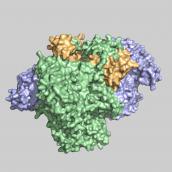Research
Influenza virus at the molecular level
Influenza viruses contain a segmented negative-sense RNA genome. Each RNA segment is assembled into a ribonucleoprotein complex with a trimeric RNA-dependent RNA polymerase (made up of subunits PB1, PB2 and PA) and an oligomer of nucleoprotein (NP). We address questions ranging from how the influenza virus RNA polymerase transcribes and replicates the viral RNA genome in the nucleus of the infected cell to how the RNA genome is exported from the nucleus and assembles into infectious progeny virus particles. We are also interested in the role of host factors in viral replication as well as in understanding the effects of virus infection on the host cell, the molecular mechanisms of innate immune sensing and host cell responses to viral infection.
Our group collaborates with structural biologists, physicists, chemists and immunologists using an interdisciplinary approach including molecular and cell biology, proteomics, single molecule and super-resolution microscopy, structural biology (x-ray crystallography and cryo-electron microscopy), and virology (reverse genetics).
Main collaborators
Jonathan Grimes (Division of Structural Biology, University of Oxford)
Nicole Robb and Achillefs Kapanidis (Department of Physics, University of Oxford)

